Mathias M. Siems*
(2007) Oxford U Comparative L Forum 4 at ouclf.law.ox.ac.uk | How to cite this article
Table of contents
- I. Introduction.
- II. Citation to Other Court Decisions
- III. Legal Methodology
- IV. Summary and Outlook
- Endnotes
I. Introduction
Today, many law journals can be accessed electronically. This is not only convenient but it also offers the interesting possibility of a quantitative analysis. In the US, this is already quite common,1 and there is no reason why this should not also be pursued in other countries.2 It is true that the mere counting of particular words could be regarded as superficial because this does not consider the specific context in which a word is used. However, some reduction of complexity is inherent to all quantitative methodologies, without implying that it is not feasible to pursue them.3 Moreover, quantitative methodology has the advantage that – in accordance with the scientific method4 – it can be used to test hypotheses empirically.
This short article employs quantitative methodology in order to analyse the adjudication of the German Federal Supreme Court (Bundesgerichtshof, BGH). It considers all decisions of the BGH which have been published in the major German law journal NJW (Neue Juristische Wochenschrift) between 1951 and 2006.5 In total, this concerns 27,562 decisions. As the number of decisions which are reported in the NJW slightly varies per year, the following figures do not show the absolute numbers per year but the hits per hundred decisions.6
A future piece will also provide comparable data for the United Kingdom. For a comparison, the present article will limit itself to formulating some hypotheses as to whether comparable data relating to UK jurisprudence should be expected to yield similar or different results.7
II. Citation to Other Court Decisions
The number of citations to other decisions does not reveal whether a court approved or disapproved these decisions. Nonetheless, this number is interesting because it indicates the degree to which previous decisions have potentially influenced a court.
1. Citation to other courts
The German Federal Supreme Court (BGH) is the highest court in matters of private and criminal law, which also includes civil and criminal procedure.8 Only when constitutional issues arise within a particular case decided by the BGH, a further constitutional complaint to the German Federal Constitutional Court (BVerfG) may lead to the BVerfG repealing a decision made by the BGH. A similar hierarchy exists between the BGH and the European Court of Justice (ECJ), because the case law of the ECJ is only relevant for the BGH if it decides about a topic which is related to a provision of the European Treaty or secondary community law.9 Foreign court decisions have no formal authority in German courts (unless relating to a matter governed by foreign law). However, it is accepted that insights gained from a comparative legal analysis may be brought in as a cognitive approach in interpreting German law.10
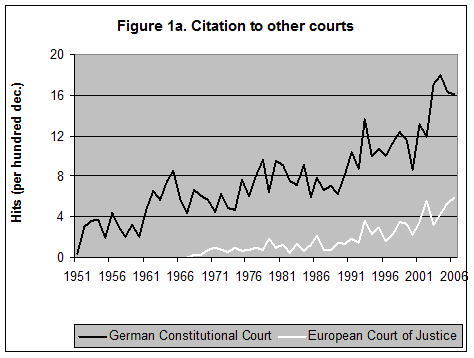
Figures 1a displays how often the BGH has cited to decisions by the German Federal Constitutional Court and by the European Court of Justice. It can be observed that the citations to the German Federal Constitutional Court11 have constantly increased. On the one hand, this could be expected because the German Federal Constitutional Court was only established in 1949, and therefore there was little case law which could have been cited to by the BGH in the 1950s. On the other hand, one may still be surprised about the extent of citations. In 2004, about 18 per cent of the BGH’s decisions mentioned the German Federal Constitutional Court. It can therefore be concluded that there is a growing ‘constitutionalization’ of private and criminal law. Examples would be legion. For instance, in private law, human rights have often been used in order to protect the weaker party of a contract (e.g., in cases of spousal guarantees12). With respect to criminal law, likely main reasons are those principles of criminal law which enjoy constitutional status, such as that there must not be a crime or punishment without the law (nullum crimen sine lege; nulla poena sine lege).13 When a case involves such constitutional principles, the German Federal Constitutional Court may rectify evident mistakes made by of criminal courts. Finally, procedural law has a constitutional dimension. The German constitution contains at least three provisions which require fairness in court proceedings.14 Thus, the German Federal Constitutional Court adjudicates on procedural questions, which subsequently makes the BGH cite the German Federal Constitutional Court.
Decisions of the European Court of Justice have also increasingly been mentioned.15 On the one hand, this too is just a consequence of the fact that previously there were no or less decisions which could have been cited. On the other hand, the increase is a result of the growing quantity of European directives and regulations as well as the expansion of the European Treaty in 1987, 1993 and 1999.16 As a consequence, in 2006 about 6 per cent of the decisions of the BGH refer to the European Court of Justice. This is still well below the citations to the German Federal Constitutional Court, but it remains to be seen how this will develop in the future.
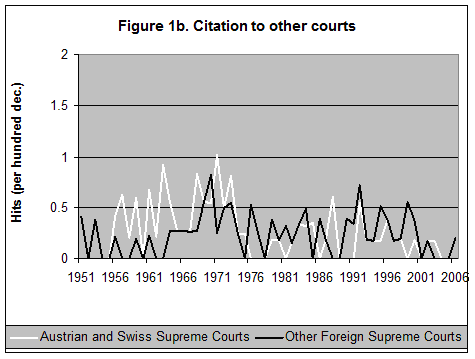
Figure 1b demonstrates how often the BGH has cited the Austrian and Swiss supreme courts17 as well as other foreign supreme courts.18 The result is that there have been 66 references to the former and 64 references to the latter courts. A quantitative analysis cannot examine in which context these foreign decisions have been mentioned. It is possible that some cases have used comparative insights in order to address a problem of domestic substantive law. Yet, when taken together, probably more cases have referred to foreign decisions in questions relating to the application of that foreign law, or of private international law, jurisdiction, and uniform international law (e.g., CISG). Regardless of this problem, the overall result is that, pro rata, few decidsions refere to foreign courts. This negative finding is in line with previous research which also found that courts rarely use comparative law.19 This reluctance is hardly surprising. Courts often lack the knowledge and the time to take comparative arguments into account. Moreover, there may be reasons based on national sovereignty, which was recently vividly emphasised by some of the judges of the American Supreme Court.20
2. Citation of own decisions
It is also interesting to examine how often and when the BGH cites to its own decisions. Figure 2 shows how frequently the decisions of the volumes 10 (1953), 50 (1968), 100 (1987), and 140 (1998) have been cited. The general shape of all four curves is that there are initially no citations, then a steep rise, and finally a smooth decline. A possible explanation for these developments is that after a first ‘excitement’ about new decisions, subsequent decisions or law reforms may modify or even reverse their findings. Additionally, it is likely that the decline over time is the result of the fact that if there is a series of similar decisions German courts usually cite the most recent decision only and add ‘m. w. N.‘ (‘mit weiteren Nachweisen‘), which means ‘with further references’. Thus, in these situations the original decision is still ‘good law’ but ‘falls victim’ of a shorthand citation.
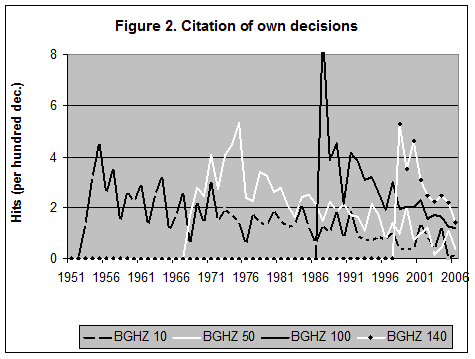
Comparing the four curves, it is, first, noticeable that the initial rise is very steep for the two later volumes (BGHZ 100 and 140), whereas for the two earlier volumes (BGHZ 10 and 50) it took a few years until the peak of citations was reached. This is likely to reflect the fact that the speed of communication has improved in the last decades, because, for instance, there are now more law journals which discuss the case law of the BGH. Secondly, one may wonder why the ‘BGHZ 100 curve’ reached a significantly higher peak than the other three curves. This could just be a coincidence. Another slightly frivolous – but still plausible – explanation could be that judges like to cite the ‘jubilee volume BGHZ 100’. Since in Germany the names of the parties are not disclosed in the judgments, only the volumes and page numbers are cited. Thus, it may indeed be the case that judges more easily remember a decision in ‘BGHZ 100’ than, for instance, in ‘BGHZ 97’.
3. Comparative remarks
In general, similar data can also be collected for the United Kingdom. However, it may be difficult to achieve full comparability with the citations of the BGH. For instance, there is no distinction between a constitutional court and a supreme court in the UK. Thus, data about decisions of the House of Lords may, to some extent, concern different subject matters than the data about the decisions of the BGH.
To elaborate for Figure 1, it is not possible to examine the citations to a constitutional court in the UK. However, an analogy may be that it can be counted how often the House of Lords has cited the European Court of Human Rights. One could expect that since the Human Rights Act 1998 (in force since 2000) the number of citations has grown. With respect to citations to the European Court of Justice, the situation may be similar to Germany, and therefore a rising curve may also be likely for the UK. Finally, in contrast to Germany, a trend may also be expected for the citation to foreign courts. Citing to courts of other common law countries has a certain tradition, but since the decision in White v Jones21 there have been a number of prominent cases in which the House of Lords has also referred to continental legal systems.22
With respect to Figure 2, the shape of the curves may be similar but not identical in Germany and the UK. In general, it is probably also the case in the UK that new decisions receive particularly strong attention. However, there may also be differences. Despite the growing importance of statutory law, case law is presumably still more important in the UK than in Germany. For a system of case law it may be likely that old court decisions are more honoured than in the civil law world. It is therefore possible (or even likely) that the ‘half-life period’ of court decisions is longer in the UK than in Germany.
A final point which needs to be considered is that Scottish cases decided by the House of Lords may display special features. As Scotland is a mixed legal system, one may, for instance, expect that references to court decisions of civil law countries or of other mixed legal systems (such as South Africa) are more common than in other decisions of the House of Lords.
III. Legal Methodology
The next figures show how often specific words which relate to legal methodology have been mentioned in decisions of the BGH. This approach has some obvious inherent limits. In some cases, the BGH may use a particular methodology without mentioning the specific word. For instance, the BGH may take the history of a particular provision into account without using the German equivalents of the terms ‘history’ or ‘legal history’ (cf. Figures 3 and 5 below). Nevertheless, it is interesting to examine how often a particular methodological term has been expressly mentioned, because in these cases the methodological concept is likely to be particularly relevant.
1. Methods of interpretation
Figure 3 relates to the four German ‘classic methods of legal interpretation’. The predominant view is that there is no ranking of these four methods but the interpretation of a particular statutory provision has to try to accommodate all of them.23 However, the statistical breakdown reveals significant differences between the actual use of terms relating to particular methods. The BGH most frequently refers to ‘wording’, then to ‘purpose’, and at the bottom end, we find ‘history’ and the ‘systemic context’ of a provision.24 The frequent emphasis of wording may indicate some formalism – or it may just be that it is often the easiest way to stick to the literal interpretation. Conversely, an interpretation based on the history or the systemic context is more burdensome and therefore perhaps less popular.
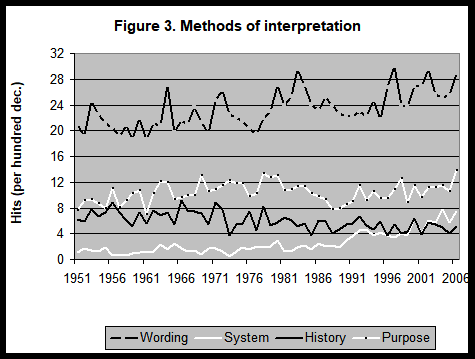
The development of these four curves also shows some interesting features. Only the ‘purpose’ has been relatively stable whereas references to ‘wording’ and ‘system’ have increased, and references to ‘history’ have decreased. A possible explanation for the increases in the importance of ‘wording’ and ‘system’ is that the German legal system has become increasingly complex. Thus, judges may either prefer ‘the easiest path’ and just stick to the wording of a particular provision, or they may try to establish how a particular provision has to be understood within the complexities of the legal system as a whole. The slow decline of historical arguments can presumably be based on the consideration that today judges regard it as less necessary to examine the history of the ‘big old codes’,25 which initially came into force in 1900.
2. Flexibility and tradition
The frequency of ‘analogy’ may indicate the degree to which judges are willing to be flexible, by disregarding the narrowness of a particular provision and extending its scope by an argument of analogy. Increased flexibility may thus offer one explanation for Figure 4, which shows a very significant increase in the percentage of decisions which refer to ‘analogy’.26 However, the better explanation may be that decisions of the BGH not only create some new analogies but also confirm the existing ones. Thus, all that can be deduced from Figure 4 with reasonable certainty is that the total number of analogies has been growing.

In Germany it is very common that judges (and other lawyers) refer to ‘the predominant view’, as a shorthand for a wide ranging agreement between courts and scholars on a particular legal issue which attracts no or few voices of dissent. It may be expected that in the course of time this has become even more frequent because more and more topics have been settled. However, the inconsistent shape of the curve in Figure 4 does not confirm this expectation.27 A likely explanation is that at the same moment when some views become dominant new problems and puzzles emerge. This curve therefore shows that the legal system is constantly evolving28 and that it will not reach a point when everything will be beyond dispute.
3. Foundations of the law
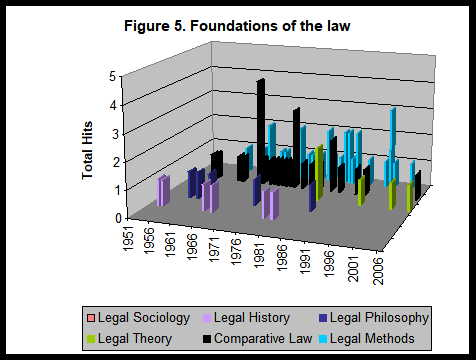
In contrast to the previous figures, Figure 5 does not show the hits per hundred decisions but the absolute numbers of hits. This representation was chosen because of the very low occurrence of any of the search terms, which were close to 0 per cent for all the terms shown in Figure 5. The first result of Figure 5 is therefore that the BGH hardly ever uses the terms ‘legal sociology’, ‘legal history’, ‘legal philosophy’, ‘legal theory’, ‘comparative law’, and ‘legal methods’.29 There are few or no citations to the first four terms, and only rarely are there references to books about comparative law and legal methods. Secondly, it is also remarkable that this has not changed in recent years. In the US, Richard Posner declared ‘the decline of law as an autonomous discipline’ 20 years ago,30 and it was also said that the 21st century is to be ‘era of comparative law’.31 Yet, a quantitative analysis of the adjudication of the BGH does not confirm these statements.
4. Comparative remarks
The main challenge of this part was to find terms which are meaningful indicators of a particular methodology. In this respect, it is the same problem in Germany and the United Kingdom that courts may use a particular method without explicitly mentioning it. However, there are different problems in both countries.
With respect to Figure 3, it is perhaps easier in the United Kingdom than in Germany to collect data about the general methods of statutory interpretation. The reason for this is that one can search for specific terms and not merely ‘wording’, ‘history’ etc. For instance, the ‘literal rule’, the ‘golden rule’, and the ‘mischief rule’ are the traditional formal rules of interpretation, which in the last years have (allegedly) become weaker in favour of a more purposive interpretation.32 This can be tested by searching for the former terms. Conversely, it is possibly less reliable to search for ‘purposive interpretation’, because courts may frequently consider the purpose of a provision without explicitly mentioning this term. A second trend which one would expect is that since 1993 references to ‘Hansard’ – the official report of Parliamentary proceedings – have increased, because the possibility of referring to it was only allowed by the landmark decision of Pepper v Hart.33 Furthermore, it would be interesting to see whether in the last few years there has been a quantifiable retreat from Pepper v Hart, as it was recently suggested.34
Figure 4, which counts ‘(legal) analogy’ and ‘predominant view’, would be problematic because the dichotomy between flexibility and tradition works differently in the UK. It is the very feature of a system which relies to a greater extent on case law that it combines both elements. On the one hand, case law is flexible because it is not restrained by comprehensive statutory law. On the other hand, case law is also conservative because it relies on judicial precedents. Thus, one has to find a different method in order to establish whether the adjudication has become more or less flexible in the UK. A possible (but not perfect) way could be to count how often the House of Lords has expressly used terms like ‘justice’ or ‘fairness’.35
With respect to Figure 5 there would presumably be very few (if any) hits of the terms ‘legal sociology’, ‘legal philosophy’, ‘legal methods’ etc. in decisions of the House of Lords. The main reason for this is that references to academic books and articles are (still) very rare in the UK, which, of course, does not exclude that in substance academic approaches to law have become more influential.36
Finally, it would again be important to examine whether Scottish cases decided by the House of Lords may display special features. At first sight the legal methodology between Scotland and the rest of the UK appears to be relatively similar.37 However, there may also be differences. For instance, in Scottish cases – even if they are decided by the House of Lords – there may be a more ‘civilian’ way of referencing, for instance, to legal writings,38 and less reliance on case law only.
IV. Summary and Outlook
Quantitative methods are no panacea and have inherent limits.39 However, they can also lead to interesting results. For instance, a quantitative analysis of the adjudication of the German Federal Supreme Court (BGH) suggests (1) that there has been a growing ‘constitutionalisation’ and Europeanisation of private and criminal law; (2) that decisions of foreign courts have usually been disregarded by the BGH; (3) that the BGH prefers to cite recent decisions; (4) that the speed in which decisions are communicated has improved; (5) that the BGH more often emphasises the wording of a particular provision than the other methods of legal interpretation; (6) that references to systemic arguments have become more, and references to legal history less frequent; (7) that the total number of analogies has been growing; (8) that it is common (but not growing) that the BGH refers to ‘the predominant view’; (9) and that references to the terms ‘legal sociology’, ‘legal history’, ‘legal philosophy’, ‘legal theory’, ‘comparative law’, and ‘legal methods’ have been very seldom in the decisions of the BGH.
A future study will extend this examination to the United Kingdom. This article already indicated that for some topics – for instance, (2) and (3) – different results may be expected, and that other topics – for instance, (7) and (8) – have to be examined with a different methodology.
Endnotes
* Reader in Commercial Law, University of Edinburgh; Research Associate, University of Cambridge. I am grateful for comments made by Gerhard Dannemann, Jill Robbie and Burkhard Schäfer. The usual disclaimer applies.
1 See e.g. Robert C. Ellickson, ‘Trends in Legal Scholarship: A Statistical Study’, (2000) 29 Journal of Legal Studies 517; Richard A. Posner, Frontiers of Legal Theory (2001) 411-440; Alfred Brophy, ‘Law [Review]’s Empire: The Assessment of Law Reviews and Trends in Legal Scholarship’, (2006) 39 Connecticut L Rev 101.
2 A rare example from Germany is Roland Wagner-Döbler and Lothar Philipps, ‘Die Verbreitung neuer Rechtsbegriffe in der Rechtsprechung. Quantitative Analysen anhand deutscher Urteilstexte aus den Jahren 1950 bis 1992’, (1995) 26 Rechtstheorie 235.
3 See also Mathias M. Siems, ‘Numerical Comparative Law: Do We Need Statistical Evidence in Order to Reduce Complexity?’, (2005) 13 Cardozo J of Int and Comparative L 521, Priya Lele and Mathias M. Siems, ‘Shareholder Protection – A Leximetric Approach’, (2007) 7 J of Corporate L Studies 17; Mathias M. Siems, ‘Statistische Rechtsvergleichung’, Rabels Zeitschrift für ausländisches und internationals Privatrecht (forthcoming).
4 See e.g. Sir Karl Popper, The Logic of Scientific Discovery (1959) and Objective Knowledge (1972); see also Mathias M. Siems, ‘Legal Originality’ (Working Paper, 2006), available at http://ssrn.com/abstract=976168http://ssrn.com/abstract=976168.
5 Available at http://www.beck-online.de (but password required).
6 With the exception of Figure 5, below.
7 See I 3 and II 3, below.
8 There are four other supreme federal courts: The Federal Administrative Court (BVerwG), the Federal Finance Court (BFH), the Federal Labour Court (BAG), and the Federal Social Court (BSG). See Art. 95 of the German Basic Law (Grundgesetz). The Federal Constitutional Court (BVerfG) and the Federal Patent Court (BPatG), while also federal courts, do not act as supreme courts for any branch of jurisdiction.
9 Details about the complex relationship between national and community law are beyond the scope of this article.
10 See Hein Kötz, Der Bundesgerichtshof und die Rechtsvergleichung, Festgabe 50 Jahre Bundesgerichtshof, Volume II (2000), 825.
11 Search for ‘Bundesverfassungsgericht’ or ‘BVerfG’.
12 See e.g. Mathias M. Siems, ‘No Risk, No Fun? Should Spouses be Advised before Committing to Guarantees? A Comparative Analysis’, (2002) 10 European Rev of Private L 509; Olha Cherednychenko, ‘The Constitutionalization of Contract Law: Something New Under the Sun?’, Electronic J of Comparative L, Vol. 8.1 March 2004, available at http://www.ejcl.org/81/art81-3.html.
13 See Art. 103(2) of the German Basic Law (Grundgesetz).
14 See Art. 19(4) (‘Should any person’s rights be violated by public authority, he may have recourse to the courts’), Art. 20(3) (‘The legislature shall be bound by the constitutional order, the executive and the judiciary by law and justice’), and Art. 103(1) (‘In the courts every person shall be entitled to a hearing in accordance with law.’) of the German Basic Law (Grundgesetz) as translated at http://www.bundestag.de/htdocs_e/parliament/function/legal/germanbasiclaw.pdf.
15 Search for ‘Europäischer Gerichtshof’ or ‘EuGH’.
16 Single European Act 1976; Treaty of Maastricht 1993; Treaty of Amsterdam 1999.
17 Search for ‘österr. OGH’, ‘öst. OGH’, ‘öster. OGH’, ‘österreichische OGH’, ‘österreichische Oberste Gerichtshof’, ‘öst. Oberste Gerichtshof’, ‘OGH and österreich*’, ‘Schweizer Bundesgericht’, ‘schweizerisches Bundesgericht’, ‘Schweiz. Bundesgericht’, ‘Schweizer BG’, ‘schweizerisches BG’, ‘Schweiz. BG’, ‘BG and Schweiz*’, or ‘Bundesgericht and Schweiz*’. This complex search list was necessary in order to exclude citations to German courts.
18 Search for ‘Supreme court’, ‘House of Lords’, ‘Court of Appeal’, ‘Cour de Cassation’, or ‘Kassationsgerichtshof’.
19 Ulrich Drobnig and Sjef Van Erp (eds), The Use of Comparative Law by Courts (1999); Hein Kötz, ‘Der Bundesgerichtshof und die Rechtsvergleichung’, in Festgabe 50 Jahre Bundesgerichtshof, Volume II (2000) 825. See also Sir Basil Markesinis and Jörg Fedtke, ‘The Judge as Comparatist’, (2005) 80 Tulane L Rev 11; Sir Basil Markesinis and Jörg Fedtke (eds.), Judicial Recourse to Foreign Law (2006); Mathias M. Siems, ‘The End of Comparative Law’, (2007) 2 The J of Comparative L (forthcoming).
20 Lawrence v Texas 123 Ct 2472, 2495 (2003) (Scalia J) and Foster v Florida, 537 US 990 (2002) (Thomas J): ‘this Court […] should not impose foreign moods, fads, or fashions on Americans’. For further examples see Pierre Legrand, ‘Comparative Legal Studies and the Matter of Authenticity’, (2006) 1 J of Comparative L 365; Toni Fine, ‘American Courts and Foreign Law: The New Debate’ (2006) DAJV Newsletter 107.
21 [1995] 2 AC 207 (HL).
22 See the cases cited in Sir Basil Markesinis and Jörg Fedtke, ‘The Judge as Comparatist’, (2005) 80 Tulane L Rev 11, at 31-2.
23 Cf. e.g. Karl Larenz and Claus Wilhelm Canaris, Methodenlehre der Rechtswissenschaft (3rd edn., 1991) 141 et seq. For a comparative account see Stefan Vogenauer, Die Auslegung von Gesetzen in England und auf dem Kontinent (2001).
24 Search for (1) ‘Wortlaut*’, (2) ‘Systemati*’, (3) ‘Entstehungsgeschicht*’ or ‘Geschicht*’, and (4) ‘Sinn und Zweck’ or ‘teleologi*’. In some cases these words may also refer to the interpretation of contracts. However, this concerns only a small minority of hits. For instance, out of a random sample of 20 decisions which referred to “Wortlaut” only one of them did not concern statutory interpretation.
25 Civil Code, BGB; Commercial Code, HGB; Code of Civil Procedure, ZPO; Criminal Code, StGB; Code of Criminal Procedure, StPO.
26 Search for ‘Analog*’ or ‘Rechtsfortbildung’.
27 Search for ‘herrschende* Lehre’, ‘herrschende* Literatur’, ‘herrschende* Meinung’, ‘herrschende* Ansicht’, ‘allgemeine* Ansicht’, ‘allgemeine* Meinung’, ‘herrschende* Rechtsprechung’ or ‘allgemeine* Rechtsprechung’.
28 See also Simon Deakin, ‘Evolution for our time: a theory of legal memetics’, (2002) 55 Current Legal Problems 1.
29 Search for ‘Rechtsvergleichung’, ‘Rechtsgeschichte’, ‘Rechtsphilosophie’, ‘Rechtstheorie’, ‘Methodenlehre’, ‘Rechtssoziologie’.
30 Richard A. Posner, ‘The Decline of Law as an Autonomous Discipline: 1962-1987’, (1987) 100 Harvard L Rev 761.
31 Esin Örücü, The Enigma of Comparative Law (2004) 216; Tim Koopmans, ‘Comparative Law and the Courts’ (1996) 45 ICLQ 545, 556. For a different view see Siems (n. 19).
32 For a brief description see e.g. Michael Zander, The Law-Making Process, 6th edn (2004), pp. 130-149.
33 [1993] AC 593, [1992] 3 WLR 1032, [1993] 1 All ER 42 (HL).
34 Stefan Vogenauer, ‘A Retreat from Pepper v Hart? A Reply to Lord Steyn’ (2005) 25 Oxford Journal of Legal Studies 629.
35 See for example White v Jones [1995] 2 AC 207 at 259 per Lord Goff: ‘The impulse to do practical justice’.
36 For this point see Vogenauer (n. 23), pp. 1212-1214.
37 See e.g. Robin M. White and Ian D. Willock, The Scottish Legal System, 3rd edn (2003), p. 259 (on Pepper v. Hart), pp. 263-265 (on the ‘literal rule’, the ‘golden rule’, and the ‘mischief rule’).
38 In particular the institutional writers and their successors. For an introduction see Hector L. MacQueen, Studying Scots Law, 3rd edn. (2004), paras. 1.47-1.48.
39 See 1., above.
© 2007 Mathias Siems. This HTML edition © 2007 University of Oxford.
The contents of this page may be downloaded and printed out in single copies for individual use only. Making multiple copies without permission is prohibited.
